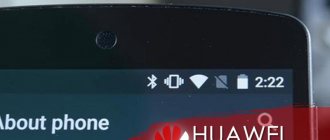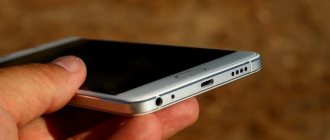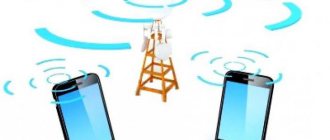Reasons for the problem
Waiting for a Wi-Fi network in the Play Market on Xiaomi can be caused by a fairly large list of reasons, such as:
- Problems with the operating system (in our case Android);
- The smartphone is connected to a router that does not provide Wi-Fi (there may be no Internet if the router is connected);
- Google service problem (rare, but solvable problem);
- Poor compatibility of the Play Store with a specific brand (Xiaomi);
- Interference from other installed applications on the smartphone (use of independent ad blockers, etc.);
- Settings mismatch (manual setting of changes).
Accordingly, there are many solutions to such problems, depending on the complexity and reasons for their occurrence. Let's consider each of the reasons separately.
Banal (simple)
As for simple solutions to this problem, we should highlight:
- Reboot your phone. Used in case of unexpected connection problems in the Android operating system itself;
- Update time and date. This may cause a malfunction in the Play Store and only after correction will it establish access to Wi-Fi;
- Wait. Sometimes, due to the huge amount of data in the market, there may be problems. In this case, you should wait a little. If everything does not improve within 2 hours, then the problem is something else;
- Removing program settings that may affect the operation of the service (for example, Freedom).
More complex
If you can cope with simple tasks without having much experience in using Xiaomi smartphones, then you will have to tinker with the rest. Connecting to a router and everything connected with it is a rather deep topic, let’s highlight the main ones:
- Checking the availability of the Internet. The device may be connected to the router, but there is no Internet;
- Availability of optimal speed. The provider must provide uninterrupted and good Wi-Fi connection speed;
- Fix device connection ban. There are cases where the connection of a specific device is prohibited;
- Correct entry of authorization data (login and password);
- Updating the router firmware;
- Reset settings to factory settings;
- There is a possibility that the router is simply faulty.
Other reasons
The above examples of problems and how to fix them are the most common. In reality there may be more reasons. Why doesn't my smartphone connect to Wi-Fi? Perhaps you installed a proxy server program that was not fully developed, caught some kind of virus, rooted the device, changed the firmware, etc. Here you need to look at the circumstances. There have been examples where the wireless connection was blocked by antivirus programs.
In general, if the connection is lost after making some changes, most likely this is the reason. If all else fails, reset your device to factory settings, remembering to first back up important applications and data.
Well, the most unpleasant thing that can happen is the failure of the Wi-Fi adapter. In this case, not only yours, but also other wireless networks will not be detected. There is nothing to do here; you will have to take your gadget to the service center.
- 31shared
- 0Facebook
- 30Twitter
- 0VKontakte
- 1Odnoklassniki
Problems with settings
Access settings are one of the key points in creating a reliable and working connection. The solution to this problem is:
- Correct changes in the Host file (leave only the base file “0.1 localhost” untouched; remove everything else);
- Checking proxy settings (if not connected only via Wi-Fi).
Waiting for a Wi-Fi network in the Play Market service on Xiaomi smartphones has become a fairly common and discussed problem for users of the brand. Does not download applications and writes about waiting for Wi-Fi - the most common requests regarding Xiaomi today. But don’t be discouraged, because following a simple algorithm of actions, you can easily fix the problem based on your situation.
Updating Network Drivers
Another common solution to network problems is updating the Wi-Fi network adapter driver, which is necessary if the network connection icon in the notification area is crossed out or is missing from the Network Connections folder.
Step 1. Press “Win+R”, type “devmgmt.msc” and click “OK”.
Type the command “devmgmt.msc”, click “OK”
Step 2. In the “Device Manager” that opens, click on “Network Adapters”, right-click on the WLAN wireless device and click “Delete...”.
Click on “Network Adapters”, right-click on the WLAN wireless device, click “Delete...”
Note! If the adapter is not in the section, it may be presented in the manager tree under a question mark or an exclamation mark in the form of “Unknown device”.
No devices
Step 3. Click on “Action” at the top of the manager and select “Update hardware configuration” from the menu.
Click on “Action” at the top of the dispatcher and select “Update hardware configuration” from the menu
Step 4. Right-click on the device that appears and select “Update Drivers” from the menu.
Select “Update drivers” from the menu
Step 5. Click “Automatic search...”.
Click “Automatic search...”
After the system finds and installs the required driver, the Wf-Fi network device will appear in “Network adapters”.
Wf-Fi network device is connected
Step 6. Follow the same steps for the LAN (Ethernet) adapter.
Step 7. If the network device has a disconnect icon, click on it and select “Enable”.
Select “Engage”
Step 8: Restart your PC and check the connection again.
Wi-Fi is connected, but says “no internet access”
There are several reasons. First: the router is really not connected to the network at the moment or is working with errors. It needs to be rebooted - you can ask the staff about this if we are talking about a restaurant or cafe. Or do it yourself: we recommend unplugging the power cord for 2-3 minutes, at the same time checking whether the Internet and ethernet cables fit tightly into their cells.
Second: you are too far from the router, and it simply does not reach your device. Try moving. If this happens at home, place the router in another place - perhaps some obstacle is preventing the signal transmission.
Third: you have not completed connecting to the network. In many public networks, a mandatory requirement is to authenticate the user on a special page that appears after you click on the “connect” button. You may have prevented the page from opening. In this case, find the network in the list of available ones, click on it and select “Delete”. Connect again and wait until the start page opens, where you will need to enter your phone number and the password that will be sent to it. If the page does not open automatically, go to the default browser installed on your phone and try to open any page - a login window should appear.
Fourth: The date and time on the phone are set incorrectly. Check your settings and enter the correct information.
Fifth: There are problems with the IP address. Go to the list of networks and long press on the one you need. Select “Change Network”, then “Advanced Settings”. Here, in the IP setting parameter, set the value to “custom” and enter 192.168.1.X (where X>1) (make sure that this data suits you by looking at the label on your router. Its IP address will be indicated there. Phone address there will be the same numbers, except for the last one - choose it to your taste.)
Sixth: It is possible that, despite the free network, the Internet is distributed only to the IP/MAC addresses of devices specified by the administrator, i.e. You won’t be able to connect without meeting the administrator.
Seventh: The connection may be blocked by a “security program”: a firewall or antivirus. Try turning them off.
The smartphone connects to Wi-Fi, but does not go online
The reason for the lack of Internet may be either in the Wi-Fi router or in the mobile device itself. To rule out a router, check on other equipment to see if there is a connection to the network. If there is Internet access there, then the problem is with the smartphone. If not, follow these steps to resolve the issue.
- First, try rebooting the router 2-3 times.
- Check the Internet payment for the current month and whether there is any technical work at the provider’s center (this can be done either by calling them, or connecting the cable directly to the computer).
- Make sure the wires to the device are connected correctly.
- Look at your router settings; they may have gone wrong and need to be configured again.
If the problem is still with your phone, check what color the icon is. If it is gray instead of blue, the data in the Date and Time section may be incorrect. Set the correct information. Reboot your phone.
Incorrect synchronization with the modem
If the Play Market does not function only via Wi-Fi, then the reason should be looked for in the router settings:
- The first step is to check the functionality of the modem. Carefully examine whether all the lights on it are lit correctly, indicating synchronization. If there are red indicators, you need to contact technical support specialists;
- If you are unable to access the Market, open your browser and try to connect to other resources. If there is no traffic at all, then no website will open from the phone. You can find out why Wi-Fi is not working by calling the service organization;
- Low connection speed. If the speeds are insufficient, the Wi-Fi network wait time in the Xiaomi Play Market may exceed. If a white picture remains on the screen for a long time, the loading indicator spins, and then it is reported that the waiting time has expired, then you need to discuss with your provider the issue of increasing the connection speed;
- Banning Internet access for your gadget. Select the “About phone” menu and click on the “General information” section. Here you will see the MAC address in use for your machine. By looking at the modem settings, you may find that this combination is on the list of prohibited MAC addresses. Remove this address and reboot the modem;
When methods for correcting software errors do not produce results, then the likely reason for the product’s inoperability lies in its failure. Wires break, antenna breaks, modules burn out—what exactly is broken can only be answered by a repair shop specialist when disassembling the device.
Network access denied
If such an error appears, check the connection of MAC filters in the router’s security settings (access control). There are white and black lists of router MAC addresses (individual serial numbers). Their availability depends on the device model.
- White - only those devices that have access to the home network are included.
- Black—addresses that are not allowed to connect are added.
Go to your phone's Settings and find the About Phone section. Go there and click “General Information”. There you will see the line “Wi-Fi MAC address”.
Why Huawei/Honor is not charging: reasons and what to do?
To eliminate the connection problem, deactivate the “MAC filter restriction mode” in the router interface by selecting “Disabled” from the list.
Now reboot your router and then your smartphone for the changes to take effect.
Setting up a firewall in Windows
One of the main functions of the application is to check the data that comes from the World Wide Web, and if a threat is detected, it is blocked. The application operates in two modes:
- The “black list” is configured to allow all programs to pass except those included in the list of prohibited ones.
- "White": blocks everything that is not allowed.
Important! Even if the program has been fully configured, after installing a new application, you need to make corrections and give permission for it to work, if possible, edit and close unnecessary ones. How to find the firewall:
How to find the firewall:
- You need to go to the “Control Panel” and use the search engine.
- In the window that opens, you can change or set the required parameters for private and public networks.
- If you have an antivirus system installed on your laptop, you can simply disable the firewall.
Blocking outgoing connections
What to do if your firewall is blocking the Internet? When the path to the Internet is blocked by an anti-virus complex or firewall, you can take the following actions and block their work with a firewall:
- Open the “Advanced Settings” item in the window.
- Select the “Properties” item and in the “Outgoing connections” item set the “Block” option in all profiles.
Application Rules
On a PC, there is a list of specific applications that are allowed to interact directly with the Internet. If the one you need is not among them, you can make an additional permit for it. To do this, you need to carry out a series of step-by-step actions:
- Go to the firewall settings and select “Applications”.
- Here select whether you need “Create” access or “Edit”
Error "Internet connection via Wi-Fi is limited"
Often laptop owners are bothered by a “popular” error when suddenly Internet access is limited and a yellow triangle with an exclamation mark appears next to the network icon. This means that access to the Wi-Fi network is prohibited. If you try to connect directly from the provider’s cable, the result will be the same: the error message “There is no Internet connection” will be displayed.
To improve the situation, you need to go through the basic, basic tips that will help solve the problem in a non-critical case. Moreover, it does not matter whether the connection is made via Wi-Fi wireless technology or using the Ethernet cable method:
- Try to restart your laptop or phone, and also restart your router.
- When connecting via cable, it is important to check that it is properly plugged into the router and that it is not damaged. The last resort would be to replace the patch cord.
- Try disabling your antivirus for a while. Sometimes blockers prevent access to the network. In this case, if the Internet appears, you should find instructions on how to allow the connection on the current antivirus in its settings.
- Check whether the service for providing an Internet connection to the global network has been paid for. Sometimes people forget to do this and get banned from the network.
- If you purchased a new router and the error occurs exactly when you first connect it, then the limited Wi-Fi connection on your phone or laptop is most likely due to incorrect factory settings of the network device itself. Some people don’t know why they need to set up a router they just bought, but it’s necessary.
- Determine exactly where the problem is hidden: in the router, in the computer (phone) or in the provider who started technical work or disable access for non-payment of services.
Important! Most often, it is the Wi-Fi router that becomes the culprit of the problem. You can check it by connecting other devices directly or wirelessly. If everything works for them, then the problem is with a single device and you need to look for it in it.
It says “saved”, but there is no connection, authentication error
If you are trying to connect to a public network in a restaurant or airport, for example, then the explanation can be very simple and offensive for you: the router’s connection limit has simply been exhausted; it cannot cope with the number of devices attacking it, eager to get into the network. This often happens in places with large crowds of people: at holidays, concerts. Any channel has a limit, and it can be difficult to feed the phones of thousands of insatiable users. Or an old router is installed and the phone simply does not support its settings. It is difficult to solve the problem in this case; all you have to do is wait or look for another network.
Also, a public network may be protected by a password and you do not know it or enter it incorrectly. Try talking to local employees, maybe they will tell you a secret, even if it is not a public network for all clients.
If we are talking about a home network, this error may indicate that the router is frozen. In this case, it can be revived by simply holding down the reset button or disconnecting it from the power supply for a couple of minutes.
If the error persists, go to the router settings via a computer (by entering the IP address of the device in the browser address bar), check that the WPA-2 encryption type is selected and the DHCP server is enabled. And yes, make sure that the password is entered correctly - on the router and on the phone. Even if it seems to you that you remember it by heart and there can be no problems with that. Sometimes, an error may occur during the typing process and you won’t even know which character is in it: just change the password and try to access the network again.
Also check the date, time and region settings on your phone and router. Their mismatch can lead to devices blocking each other.
Authentication Error
The reason for the error that occurred during authentication was that the Wi-Fi password was entered incorrectly. Make sure that the input language is correct and you are not using Cyrillic instead of Latin. Check the correct case of letters.
If you have any questions or complaints, please let us know
Ask a Question
To eliminate the source of the problem, delete the wireless network (“Forget…”) and reboot the router.
If restarting the router and searching the network again did not help, change the password again through the router settings.
- Look for information for logging into the web interface on the device body.
- Once logged in, change your password using the Latin alphabet and numbers.
- Look at the standard - it should be WPA2-PSK.
Or select WPA, WPA2 mode if it is not supported by your smartphone. Unfortunately, while on public transport or in a shopping center, you will not be able to change the “Security Settings” of the router. Wait until you arrive home.
Perform a hard reset on your smartphone
This is far from the best option, but if the solutions described above did not work, then it is definitely worth giving it a chance. Performing a factory reset will get rid of any software errors on your device that may have caused connectivity issues.
This is done very simply and does not take much time. However, this will destroy all data (images, apps, documents..) from your device, so make a backup first.
Just open Settings and look for the Backup & Reset menu, which may be called something else on your device. Click on it, select the factory reset option and erase data from your device.
Once the smartphone turns on again, you will have to go through the setup process as when you first used it. Once this is done, turn on Wi-Fi, select your network and try to connect by entering the password. We hope everything works and you can connect to the Internet without any problems.
None of the above helped
If after these steps you cannot connect your smartphone to the Wi-Fi router, the problem is with the gadget. Reset it to original settings:
- go to the “System” section;
- select “Reset settings”;
Due to the fact that system files may have been damaged, a global reset is required. After the phone reboots, update to the latest version of Android - “System” > “System Update”.
In our material, we outlined possible errors when connecting to a Wi-Fi network and how to eliminate them. We hope you were able to use the information posted and were able to connect to the Internet without any problems.
What can cause connection problems?
Before starting to analyze the problems, it should be noted that Wi-Fi itself does not have access to the Internet, but only distributes it and expands the wireless communication network. The router must be connected to the provider's cable and only then will it be able to extend the network to all home devices. This means that if the network does not connect on the laptop or the “Restricted” error appears, then the problem should be looked for in the router configurations.
In addition, the following failures are possible:
- The client did not pay for the provider’s services on time and was temporarily disconnected from the Internet;
- The Wi-Fi router failed due to overloads in the home network or for other reasons;
- There was a problem with the software of the router or wireless Wi-Fi adapter on your laptop or phone.
Checking router settings
Each reason should be examined in more detail. First of all, you need to connect to the router wirelessly or via cable. In any of these cases, after performing this action, you need to go to the router settings. To do this, enter its address in the address bar of any browser, which can be found on the back or bottom of the device. The information for logging into your settings account is also indicated there. By default they are admin:admin.
If you cannot find the address, you should use the console. You can open it by clicking on the “Win + R” combination and writing the line “cmd” in the “Run” window. In the command line you need to write “ipconfig” and press “Enter”. After this, all the necessary information will appear on the screen, among which you need to find the line “Main gateway”. This will be the address of the router settings.
The web interface of different models may differ, but the steps performed in the article are valid for absolutely all devices. The first step is to find the tab in the configurator with WAN settings - connection to the global network. Connection information is indicated here. For detailed settings, select “Dynamic IP” as the connection type and fill in the fields with the data provided by the operator in the contract. If the contract is lost, you can call the support service and ask for help.
Internet restrictions can also be a consequence of purchasing new equipment or changing the MAC address. The latter is registered on the provider’s servers and used to log in. Changing it prevents the router from being authenticated.
Important! You can solve the problem by changing the address manually, but it is better to contact support to change it. After all these steps, the router will have to reboot
On the phone
To solve a problem with a specific mobile device, you also need to follow a number of recommended actions:
- First of all, you need to check whether network search is turned on on your smartphone at all;
- It is recommended to restart the device if the search for networks is enabled, but the phone does not connect to the selected network or connects, but the Internet is limited;
- You can also try to clean your phone of excess debris and install firmware updates if available.
Go to Device Manager using the Run window
On the computer
Certain problems may also arise on a personal computer or laptop. Most often this is due to the fact that the network card settings have gone wrong. In most cases, you need to change the IP address and DNS settings. This requires:
- Go to Control Panel via the Start menu;
- Find “Network and Sharing Center” and select the “Change adapter settings” link on the left;
- In the adapter settings, select the active connection and select its properties with the right mouse button;
- In the Properties window, you need to find IPv4 in the list of parameters and select it;
- In the window that opens, you need to check the boxes next to the items “Obtain an IP address automatically” and “Obtain a DNS server address automatically”;
- Save the settings and restart the computer.
Router problems
When an external signal is clearly “audible” on the router, but the computer cannot “catch” the Internet via a wireless network, you should check the presence of the network from another device - for example, from a smartphone/tablet, or from another PC. If mobile gadgets also do not work, then the problem lies in the router (another name for a router). If the connection on another device is working, then you should move on to the next section of the article - PC problems.
A router is essentially a small computer with its own processor, memory and a miniature operating system - firmware. From time to time, problems arise with it - like any computer. When the router stops working, first try rebooting the access point and wait a couple of minutes. Often this action is enough to restore Wi-Fi operation.
Fig: Logging into the router control panel: you need to enter the address 192.168.1.1 into the browser (on some models - 192.168.0.1)
You need to log into the router control panel. To do this, enter the address: 192.168.1.1 into the address bar of any browser (some models have a slightly different address: 192.168.0.1). You can usually find out the router’s address in the device’s instructions, and sometimes it is printed on the access point’s body. The browser will ask for your username and password (usually the admin/admin pair).
By the way, if the computer requests authorization, this means that the router is just not distributing the Internet, but the Wi-Fi itself is working. If the login and password prompt does not appear, this means that the wireless network is completely absent. Try this: connect to the router wired - it comes with a short network cable. One end needs to be inserted into the port on the computer, the other into the port of a working router. After that, enter the address 192.168.1.1 into the browser again.
Got an "authentication error" message? Try entering your password and login again: in Latin letters, without using capital letters; You can also find out your login and password in the instructions. When everything is entered correctly, the main page of the control panel will open.
Although the design and interface language of each router manufacturer are different, there are general principles for working with the control panel. We will look at solving problems with Wi-Fi using the example of a TP-Link device.
Fig: Main page of the access point web interface.
Finding reasons in the router settings
Often connection problems are associated with parameters that are incompatible with the mobile device, be it the type of protection, operating mode (n, g, ac and the like), channel (number or width), region, etc. You can try changing them and connecting again (while rebooting the device and deleting the network from the phone, logging in again, entering the security key). If changing one setting doesn't do anything, revert to the old value (write down the settings you change) and move on to the next setting.
Checking the network region
This issue occurs if the network region is not configured correctly. It is enough to check the region in the router settings and change if necessary if the data does not correspond to reality.
Find the “Wireless Mode” item in the menu on the left, expand it and click on “Wireless Mode Settings”. On the right you will see the line “Region”. After changing it, reboot the device, try connecting your phone to the Wi-Fi and make sure that the error disappears.
Checking the wireless network operating mode
In specific cases, the operating mode assigned in the router configuration may not be supported by the mobile device, which is why problems occur when trying to connect.
In the submenu “Wireless mode settings” there is a line of the same name, by clicking on which you can change the operating mode to another, and then reconnect from your mobile device. If a specific mode is installed, select Auto, if Auto, then vice versa, select one from the list. With each change, it is strongly recommended to reboot the router, as well as turn off and turn on Wi-Fi on your phone, connecting to the network anew each time.
Encryption type
It is possible that the type of encryption configured in the router is causing the error. WPA2 PSK protection is preferred for installation as it has no problems with Android devices. If a different type is specified in the web parameters, you need to change it.
Go to the “Wireless Mode” section, “Wireless Protection” subsection and select “WPA-PSK/WPA2-PSK”, set AES encryption and enter a password.
After the changes have been made, you need to turn off and turn on the router, delete the connection from the phone and reconnect again.
Switching from WPA2 to WPA (AES) often helps.
Channel width
One of the rarest reasons why a problem with connecting to an access point occurs is the channel width. A WiFi device can operate on a channel that is overloaded with other devices. In this case, the channel must be changed or the width of the already set one increased. This is also done through the device's WiFi web interface.
In the third line you can change the channel width, which is displayed in megahertz. Available options include Auto, 20 MHz and 40 MHz. If the maximum width is already assigned, try changing the channel to another one. You can choose from 13 options, but you should limit yourself to 11, since that’s how many frequencies are supported on phones.
After configuration, you should confirm the changed configuration, reboot the router and reconnect to it from your mobile device.
Checking the time zone
If your phone is set to the wrong time zone, then this is one of the reasons why your phone won't connect to WiFi. Check that the specified belt is correct in the mobile device configuration.
Authentication Error
The phone cannot connect to Wi-Fi due to an authentication error. In English it sounds like Authentification Error, which means you entered the password incorrectly. Authentication is required for a secure connection.
- Again, check that the password is entered correctly, if necessary, delete the network and detect it again.
- Through “Router Settings” you can change the key.
- It is possible that during initial setup, the encryption settings were specified incorrectly.
- The recommended option is to install WPA2 Personal and the AES algorithm, as in the screenshot.
- Due to neighboring networks, connection interference may occur, which requires changing the value of the “Channels” item back to “Auto”.
How to connect Honor Sport AM61 to your phone and PC: instructions
For all changes to take effect, reboot the router by unplugging the equipment from the outlet and plugging it back in.
Reinstalling the driver
It is worth remembering that many programs introduce settings into the system that are difficult to find and undo. They should not be used unless absolutely necessary, either on the phone or on a personal computer. In addition, desktop operating systems have their own standard troubleshooting methods, which are prioritized for use due to fast and stable operation.
If all of the above does not help to cope with the problem, then you should try reinstalling the drivers for wireless and wired network adapters, and also update the latest firmware version to your router. This will reset all old data and configurations and replace them with the optimal settings. To update the drivers, you should open the “Device Manager” by entering its name in the “Start” menu or finding it in the “Control Panel”. You can also open the required window through the “Run” function by entering the command “mmc devmgmt.msc”.
Next, you need to go to the “Network adapters” item and select the active adapter. By right-clicking you can find the driver update item, but it is better to delete all network connection items. After this, the computer is rebooted and all the necessary drivers are installed from a disk or flash drive, where they are located in advance or downloaded from the official website. When the installation is complete, the computer will restart and you can try to connect to the network again.
If your computer can't connect to a working Wi-Fi network
Often laptops are equipped with additional function keys for controlling devices: sound, touchpad, wireless adapter. Try to find the button with the Wi-Fi icon in the top row of the keyboard (F1 - F12) and press it simultaneously with the Fn key (bottom row). If the adapter does not work (it was turned off by accident, or to reduce power consumption), then after pressing this combination it will work again. You can check whether the adapter is turned on using the wireless icon near the Windows clock: a cross on the icon or the absence of an icon indicates that the adapter is turned off.
When the wireless network works on other devices, but in the Windows tray the wireless network icon is crossed out (or is completely absent) - the problem with Wi-Fi lies in a specific computer, and not in the network itself. This means that only this device fails to connect, but the Wi-Fi itself is operational. If the icon is marked with a yellow-orange dot, then try clicking on it and looking for the name of your network. It was found, but when entering the password an authentication error pops up? The problem is the wrong layout, the Caps Lock key pressed, or simply the wrong password.
In the case of a desktop PC, you must physically remove and reconnect the Wi-Fi adapter (usually a device the size of a flash drive, connected to the USB port at the back of the case). If the adapter is a built-in type (or we are talking about a laptop), try checking its functionality: right-click on “My Computer” / “Computer” - “Properties” - “Device Manager”.
Take a look at the “Network adapters” section: if one of them, especially those with the word Wireless in the name, is marked with a question mark, exclamation mark or cross, then the problem is a conflict between this device and Windows or with another PC node. It is enough to download the latest drivers for the wireless adapter and install them again - after this operation, the computer usually sees the network again.
In this case, an attempt to click on this control causes a message: unable to connect to the network.
The adapter is definitely turned on, the drivers are installed and there is no hardware conflict in the Device Manager, but the Internet still does not appear on the computer? There is probably a software problem with the networks. Let's check in the Windows Network Connection Center whether the OS considers this adapter to be enabled.
Fig: Windows Network Sharing Center
In the left part of the Center you need to select the “Change adapter settings” section. All Windows network adapters will appear in the next window. Take a look at the screenshot below: the wireless adapter in this case was turned off by software (highlighted in gray). In this case, the Internet does not work solely because the adapter is turned off. To enable it, just right-click and select “Enable”.
Fig: Software enable the wireless adapter
Finally, sometimes Wi-Fi experiences network incompatibility issues between devices. The router refuses to connect to the IPv4 protocol parameters that Windows offers it. You should “submit” to the router and give it the right to independently assign the network configuration. It sounds complicated, but in practice it's just one small adjustment.
Fig: Resetting the network adapter configuration in Windows
In the Network and Control Center, you need to select the current wireless connection, find the “Properties” item in it (screenshot on the left). In the dialog box that appears, find “Internet Protocol Version 4” and select “Properties” again. A window with IP address parameters will open. It is recommended to select automatic network configurations - so that the router can independently assign IP and DNS addresses (screenshot on the right). This method helps especially well if manually entered network addresses were visible in the window as in the right screenshot. This configuration is incorrect, and the computer does not see the network.
What can cause connection problems?
Before starting to analyze the problems, it should be noted that Wi-Fi itself does not have access to the Internet, but only distributes it and expands the wireless communication network. The router must be connected to the provider's cable and only then will it be able to extend the network to all home devices. This means that if the network does not connect on the laptop or the “Restricted” error appears, then the problem should be looked for in the router configurations.
Error “Saved, WPA/WPA2 protection” - why Wifi won’t connect
In addition, the following failures are possible:
- The client did not pay for the provider’s services on time and was temporarily disconnected from the Internet;
- The Wi-Fi router failed due to overloads in the home network or for other reasons;
- There was a problem with the software of the router or wireless Wi-Fi adapter on your laptop or phone.
Checking router settings
Each reason should be examined in more detail. First of all, you need to connect to the router wirelessly or via cable. In any of these cases, after performing this action, you need to go to the router settings. To do this, enter its address in the address bar of any browser, which can be found on the back or bottom of the device. The information for logging into your settings account is also indicated there. By default they are admin:admin.
If you cannot find the address, you should use the console. You can open it by clicking on the “Win + R” combination and writing the line “cmd” in the “Run” window. In the command line you need to write “ipconfig” and press “Enter”. After this, all the necessary information will appear on the screen, among which you need to find the line “Main gateway”. This will be the address of the router settings.
The web interface of different models may differ, but the steps performed in the article are valid for absolutely all devices. The first step is to find the tab in the configurator with WAN settings - connection to the global network. Connection information is indicated here. For detailed settings, select “Dynamic IP” as the connection type and fill in the fields with the data provided by the operator in the contract. If the contract is lost, you can call the support service and ask for help.
Internet restrictions can also be a consequence of purchasing new equipment or changing the MAC address. The latter is registered on the provider’s servers and used to log in. Changing it prevents the router from being authenticated.
Important! You can solve the problem by changing the address manually, but it is better to contact support to change it. After all these steps, the router will have to reboot
On the phone
To solve a problem with a specific mobile device, you also need to follow a number of recommended actions:
- First of all, you need to check whether network search is turned on on your smartphone at all;
- It is recommended to restart the device if the search for networks is enabled, but the phone does not connect to the selected network or connects, but the Internet is limited;
- You can also try to clean your phone of excess debris and install firmware updates if available.
On the computer
Certain problems may also arise on a personal computer or laptop. Most often this is due to the fact that the network card settings have gone wrong. In most cases, you need to change the IP address and DNS settings. This requires:
- Go to Control Panel via the Start menu;
- Find “Network and Sharing Center” and select the “Change adapter settings” link on the left;
- In the adapter settings, select the active connection and select its properties with the right mouse button;
- In the Properties window, you need to find IPv4 in the list of parameters and select it;
- In the window that opens, you need to check the boxes next to the items “Obtain an IP address automatically” and “Obtain a DNS server address automatically”;
- Save the settings and restart the computer.
What to do if your phone does not connect to Wi-Fi
Now let’s take a closer look at each solution to resolve the error that has occurred due to which it is impossible to connect the smartphone to the Wi-Fi router.
Removing the network
This method involves deleting network settings (IP address, DNS, etc.). The next time you connect, new settings are automatically assigned, that is, all errors should also be eliminated. Go to the wireless network selection menu and press the desired one with your finger. From the drop-down list, select “Delete this network.”
Correcting authorization data
To check that your password is correct, log into your network. To view, click next to the icon with a crossed out eye. The code will be displayed. You may not have changed the input language or letter case. To change the password, open the router interface through a browser and in the “Wireless Protection” section, enter a different authorization key.
How to take a photo with a blurred “Bokeh” background on Huawei and Honor
Checking Signal Characteristics
The signal strength can be checked using a special program. Based on the results, you will understand where to start setting up. Perhaps the Internet is not available due to the fault of the service provider.
Setting up the router
Go to the router's Wi-Fi interface. You need to change the communication channel, version and type of encryption. If necessary, make changes to the network name and password.
Time and date
Open “Settings” on your mobile device by clicking on the “gear” icon. There you will see the “System” section, and in it “Date and Time”. Make sure the information is consistent according to your region. If the network values differ, errors may occur during data transmission.
DNS problem
Press and hold the wifi network and from the window that appears, click on the “Change network” item.
In “Advanced Settings”, click on DHCP and select “Custom”. Scroll down. In DNS1 and DNS2 we enter 8.8.8 and 8.8.8.4, respectively. Confirm saving.
Proxy server on Android
Open Wi-Fi settings. Go to "Advanced Settings". Check that the value next to the “Proxy server” line is “No”. This means that it is inactive.
Uninstalling programs
Remember, you may have recently installed third-party applications on your mobile device. Review everything, and if any program seems suspicious, it is better to remove it. Some programs may block your Internet connection. Go to the application and click "Stop" to stop it. And then delete.
Reset the network, or completely reset the phone (Android)
Open the “Settings” of your smartphone and go to the “System” section. Select "Reset settings" according to the task. You can reset your WiFi, apps, or phone to factory settings.
Firmware update
Check for new updates for your router and mobile device. If there are any, update them. This may be the reason for the lack of connection.
Installing applications
Today it is possible to download an additional application through the Play Market that will help set up a wireless network. Among the recommended ones, we offer Fix WiFi, WiFi Fixer and WiFi Doctor. The programs will eliminate all problems that have arisen and increase download speed. The third program will even notify you if someone else's user connects to your network.
Virus check
To check your smartphone for viruses, download an antivirus program from an online store. For example, Dr. Web. After installation, start scanning your phone. Remove malicious files. Save important files and reset your phone to factory settings. Update your system to the latest version of Android.
Difficulties with access settings
If they are performed incorrectly, then it is necessary to correct possible errors, including:
- Checking the main file responsible for the device’s interaction with the wireless Internet. To do this, you will need a specialized explorer or Hosts Editor, and a mandatory condition for using them is the presence of root rights. The file is located at “/etc/hosts”. It is worth checking to see if there have been any changes to it, for example due to the installation of an ad blocker or manual editing. There is a possibility that the file may be damaged by viruses. It is “treated” in this way: all contained information is deleted, with the exception of “0.0.1 localhost”. Save the changes and reboot the product;
If all the advice we offered did not have the desired effect, then the most radical remedy remains - reinstalling the operating system. It is strongly recommended to use global stable firmware, which will not have any bugs or shortcomings.











